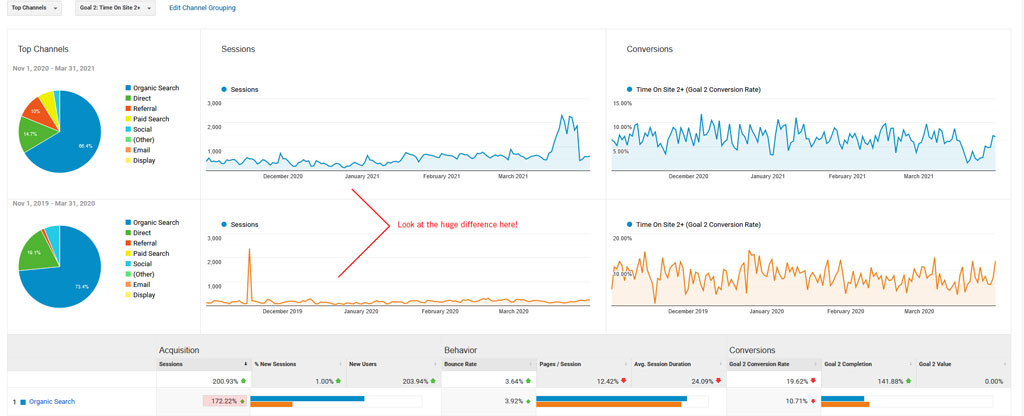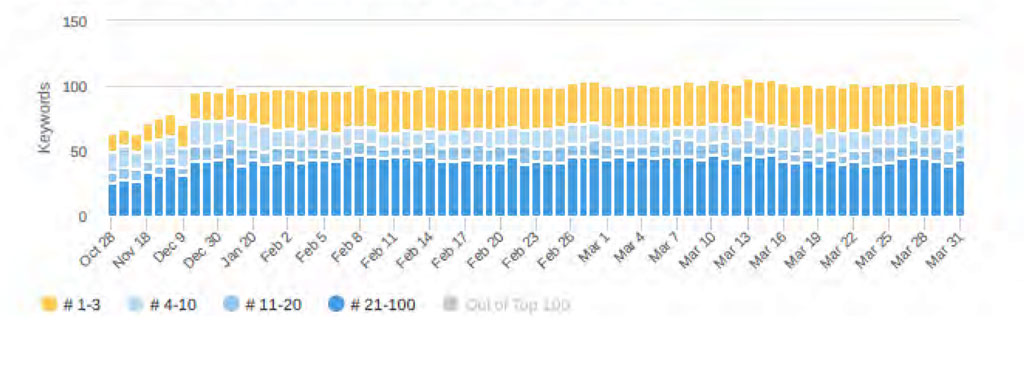Executive Summary/TLDR
Law firms with existing blogs can often see increases in both traffic and conversions by reoptimizing content. In this post, we look at the results we achieved for a client by reoptimizing existing content. As part of a larger strategy, this effort saw organic traffic increase by nearly 200%, over only four months. And we’ve only reworked approximately 25% of all site content.
This post is written from an enviable position. Many of our typical engagements with law firm or professional service clients center around launching a new firm blog. Rarely are we working with firms with longstanding blogs, who are looking to us for suggestions on increasing visitation and conversions from existing content. In this case, though, our client has been writing content since at least 2009. As part of a holistic review of their content strategy, we suggested reoptimizing underperforming posts. That strategy yielded results that even the most wild-eyed optimist would be happy with.
Old content doesn’t die. It just gets repurposed.
There are many reasons to rework, rather than retire existing blog content. We’ll talk about a bunch of those in a bit but, first, let’s look at our client’s situation. As I mentioned our client, a tax law firm near San Francisco, has been writing about tax issues since the mid-2000s. Their clients span a range of small to large businesses, along with individuals. Historically, their content covers a range of tax-related issues, including California-specific tax concerns, international taxation, estate planning, trending changes to US tax law, etc. These are explored both in their practice area pages and the legal blog they write.
Over the 10+ years they’ve been blogging, they did not adhere to formal, preconceived editorial calendars. They wrote about what was topical, what was a particular practice area strength, and whatever else struck their fancy. Despite having an annual strategy, their posts are well-written, often in-depth, and have garnered very healthy traffic over the years.
When we were asked, then, to increase blog and site traffic, we saw tremendous opportunity to mine some gold from the substantial vein of content they had made. The fact that most of their posts were not keyword researched and they wrote on impulse led us to see two potential strategy improvements we could make:
- Reoptimizing Old Blog & Website Content: Because the existing posts were typically not the product of formal keyword research, we supposed that a process of reoptimizing the content might produce significant increases in traffic for the posts. Our thinking went something like this: “If content was originally written without cross referencing what typical phrases are being used by searchers to find that content, maybe reoptimizing the original content could attract more traffic.”
- Reduce Content Cannibalization: Ten years is a long time to be writing content consistently. Even thoughtful annual calendars would have invarably produced posts which were competing against one another for the same keywords. Part of our strategy then, was going to involve auditing for content cannibalization. We edited posts, where appropriate. On occasion, we’d delete posts that were both redundant and no longer relevant.
Gain marketing insight, and put it to work.
The latest in web design, development, and inbound marketing.
Readable. Actionable. Not going to harvest your email address for mega-corporations.
The reoptimization process.
It might be useful to explore why reoptimizing many posts worth of content makes sense in the first place. Keyword research is a very useful way to test a writer’s assumptions. Often times, for instance, the way in which a professional might talk or write about a topic is different from the way their clients might. For instance, I recently tore my rotator cuff. As a further complication to the original injury, I eventually ended up seeing an orthopaedic surgeon for a consult because I was in great pain and had limited movement in the joint. He diagnosed the condition as ‘adhesive capsulitis.’ That’s the medical term or a term more popularly known in the world of physical therapy as ‘frozen shoulder.’ If I were writing a post on my condition then, a post targeting the keyword ‘adhesive capsulitis’ is more likely to attract practitioners or doctors. Writing the post with the focus on the keyword ‘frozen shoulder’ is more likely to attract patients.
When we undertake reoptimization projects like this, we typically segment our efforts according to content ‘tiers’ within the website. The top tier of content in a law firm website includes the homepage, practice areas — anything visitors encounter at the top level of navigation. In this case, we began with the homepage, moved on to practice areas and are now focusing on the blog. I won’t sugar coat this process: it’s a tedious one.
We begin by looking at traffic analytics for a list or URLS for the given content area. For the blog, we’ll start our efforts at looking at lower-performing pages. We’ll identify pages we think should be performing better. We’ll put those pages in a spreadsheet and evaluate what keywords each post was written for and, then, we’ll cross reference those with the keywords that research tells us should have been used.
Once we’ve identified our keywords, we edited all content, replacing the old keywords with the new. This process is not an automated cut-and-paste operation; you’ll want a good writer to do it, as content will need to be subtly changed. (And, don’t forget, headlines are likely your most important content element to change!) Once the post itself has been changed, we then altered Meta tags for the post, ensuring that those now contain our new keyword.
Stop letting your content eat itself. Fixing content cannibalization.
The workflow for fixing content cannibalization isn’t all that different from the reoptimization workflow. Using a tool like SEMRush, for example, we identified content that was ranking for similar keywords. Using this list, we then evaluated competing posts. Were they all worth keeping? Had some become obsolete because of, say, changes in tax law? In a perfect world, our goal would be to keep all the posts. And, during this process, we did permanently clean out some outdated content. For the others, we chose one ‘authoritative’ page that we reworked, to align with our desired keywords. For the other pieces of competing content, we’d migrate keyword usage to a related, not non-competing set.
So how did we do?
This is an ongoing process for us but the results, so far, have been nothing short of extraordinary, as the reporting screenshots below reveal.

Increases in Organic Traffic
To summarize, we have seen an incredible 172% increase in organic search traffic, in the same four-month period, from last year to this year. The rate of client’s posting has not changed considerably; leading one to the reasonable conclusion that the increases are largely do to the renewed emphasis on strategic optimization.

Increasing Occurrences of Posts Ranking in Top Three of SERPS
Much of the increase in traffic is likely the result of our targeted reoptimization pushing up a number of posts into the top three organic results. It’s a well-known truism in SEO that searchers are much more likely to click only the top one to three results in search. Increasing the number of posts with high rank, then, has an outsized effect on traffic, ultimately.
A Few Final Thoughts
As both a writer and a marketer, I find nothing wrong with a professional services firm writing about what they think is important and topical. That’s what our client has been doing for over a decade now, on their legal blog. But, this exercise in reoptimization has proven that conducting some rigorous keyword research can have profound results on search volume. In this exercise, we were largely engaged in simply aligning the keywords are clients were using organically, with keywords used by actual searchers. We really served as their literary editors, which is a role keyword research often plays.